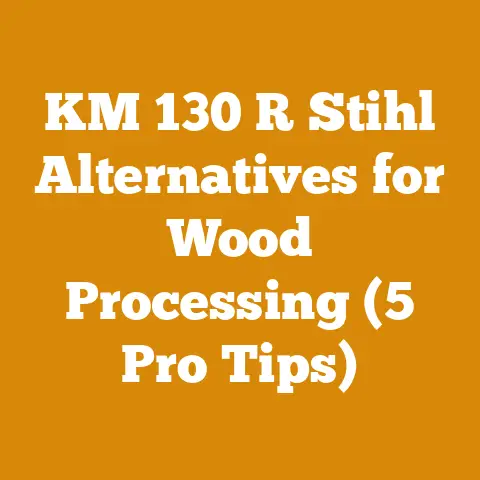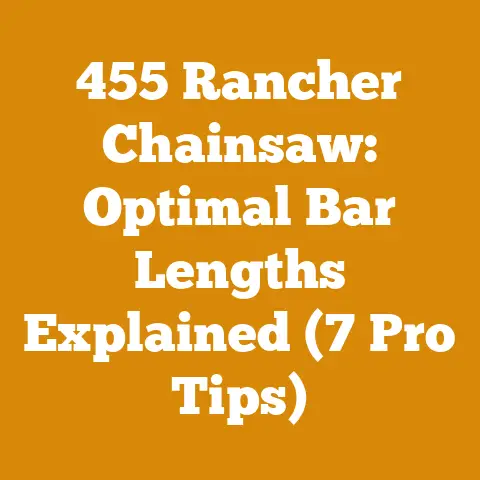What Wood Is Yellow When Split? (5 Expert Tips for Identification)
“You know, that yellow wood is going to make a stunning tabletop,” remarked renowned furniture maker, Thomas Greenly, during a recent woodworking expo. His discerning eye, honed over decades, immediately recognized the unique appeal of wood sporting that telltale yellow hue upon splitting. But what exactly is that yellow wood? And more importantly, how can you identify it? This article delves into the fascinating world of yellow-toned wood, offering expert tips and cost considerations for your woodworking or firewood endeavors.
What Wood Is Yellow When Split? (5 Expert Tips for Identification)
The allure of yellow wood lies in its distinctive color, often hinting at unique properties like durability, workability, or even aromatic qualities. However, pinpointing the exact species can be tricky. While freshly split wood might display a vibrant yellow, the color can fade or change with exposure to air and light. This guide provides five expert tips to help you identify that enigmatic yellow wood, combined with insights into the costs associated with harvesting and processing it.
1. Visual Examination: More Than Just the Yellow
The initial visual inspection goes beyond just noting the yellow color. Consider these aspects:
- Color Intensity and Distribution: Is the yellow a deep, saturated hue, or a pale, almost creamy tint? Is it evenly distributed throughout the wood, or concentrated in the heartwood or sapwood? For instance, Osage Orange, known for its vibrant yellow heartwood, can appear almost orange when freshly split, gradually mellowing to a brownish-yellow with age. In contrast, Yellow Poplar often exhibits a softer, more diffused yellow.
- Grain Pattern: Is the grain straight, wavy, interlocked, or spiral? The grain pattern provides vital clues. Yellowheart (Pau Amarillo), for example, boasts a relatively straight grain, while some varieties of yellow birch might exhibit a more figured appearance.
- Texture: Is the wood coarse or fine-textured? Yellow Pine typically has a coarser texture than Yellow Cedar. Running your fingers across the split surface can reveal subtle differences in texture, aiding in identification.
- Growth Rings: Are the growth rings distinct or indistinct? Are they wide or narrow? Wide growth rings often indicate faster growth, which can affect the wood’s density and properties.
- Bark Characteristics (if available): The bark can be a crucial identifier. Osage Orange has a distinctive orange-brown bark with deep furrows, while Yellow Birch has a smooth, yellowish-bronze bark that peels in papery strips.
Cost Consideration: Visual grading and sorting of logs based on these visual characteristics directly impact timber prices. Higher grade logs with desirable grain patterns and minimal defects command premium prices. As a small-scale logger, I’ve learned to meticulously assess each log to maximize its value at the mill.
2. The Smell Test: Aromatic Clues
Many yellow woods possess distinctive scents. This is because certain compounds within the wood give off unique aromas.
- Cedar: Yellow Cedar (Alaska Yellow Cedar) has a characteristic cedar scent, often described as slightly sweet and resinous.
- Sassafras: Sassafras, while not always distinctly yellow, can exhibit yellowish hues and has a strong, spicy aroma reminiscent of root beer.
- Other Aromatic Woods: Some other yellow woods may have faint, earthy, or even citrusy aromas.
Caution: Be aware that some woods can cause allergic reactions. Always wear appropriate respiratory protection when working with wood, especially when sanding or sawing.
Story Time: I once worked with a batch of wood that had a faint, almost lemony scent. Initially, I couldn’t place it. After some research and cross-referencing with wood identification guides, I realized it was likely a type of imported yellowheart. The unique aroma added a special touch to the finished project.
Cost Consideration: The aromatic qualities of certain yellow woods, like Yellow Cedar, contribute to their value, especially in applications like closet lining and sauna construction. Demand drives up the price. The cost of harvesting and processing these aromatic woods often reflects this premium.
3. Density and Hardness: The Feel of the Wood
Density and hardness are important indicators of wood species.
- Density: Is the wood heavy or light for its size? Dense woods tend to be stronger and more durable.
- Hardness: How resistant is the wood to scratching or denting? You can perform a simple scratch test with a fingernail or a brass tool. Softer woods will scratch more easily than harder woods. The Janka hardness test measures the force required to embed a steel ball into the wood, providing a standardized measure of hardness.
Here’s a table comparing the Janka hardness of some common yellow woods:
| Wood Species | Janka Hardness (lbf) |
|---|---|
| Osage Orange | 2620 |
| Yellowheart | 2430 |
| Yellow Birch | 1260 |
| Yellow Pine (Southern) | 690 |
| Yellow Poplar | 540 |
| Yellow Cedar | 580 |
Source: Wood Database (https://www.wood-database.com/)
Cost Consideration: Denser, harder woods generally cost more due to their superior durability and resistance to wear and tear. The cost of cutting, shaping, and finishing these woods can also be higher due to increased tool wear and the need for specialized equipment.
Personal Insight: I once underestimated the hardness of Osage Orange. I attempted to cut it with a dull blade, resulting in significant tear-out and frustration. Lesson learned: always use sharp, high-quality tools when working with dense hardwoods.
4. The Water Test: Observing Absorption
The water test can reveal valuable information about the wood’s porosity and density.
- Procedure: Place a small drop of water on a freshly split surface. Observe how quickly the water is absorbed.
- Interpretation: Woods with large pores and lower density will absorb water more quickly. Denser woods will resist water absorption.
Example: Yellow Pine, with its relatively open grain, will absorb water more readily than Yellow Cedar, which has a tighter grain structure.
Cost Consideration: The water absorption rate affects the wood’s suitability for outdoor applications. Woods with low water absorption are more resistant to rot and decay, making them ideal for decks, siding, and other exterior projects. The cost of treating wood to improve its water resistance adds to the overall project cost.
5. Microscopic Examination (Advanced): Cell Structure Analysis
For precise identification, microscopic examination of the wood’s cellular structure is the gold standard. This requires specialized equipment and expertise but provides definitive results.
- Procedure: A small sample of the wood is prepared and examined under a microscope. The size, shape, and arrangement of the cells (e.g., vessels, fibers, rays) are analyzed.
- Interpretation: Each wood species has a unique cellular structure “fingerprint.” By comparing the microscopic features of the unknown wood to known references, the species can be accurately identified.
Cost Consideration: Microscopic wood identification is typically used in situations where precise species identification is critical, such as in forensic analysis, museum conservation, or high-value woodworking projects. The cost of this type of analysis can range from $50 to $200 per sample.
Expert Tip: Many universities and forestry research institutions offer wood identification services. Contact your local extension office for referrals.
Specific Yellow Wood Species and Their Costs
Now, let’s explore some specific yellow wood species and their associated costs:
Osage Orange ( Maclura pomifera)
- Characteristics: Exceptionally hard, dense, and durable. Heartwood is a bright yellow when freshly cut, turning brownish-yellow with age. Highly resistant to rot and insects.
- Uses: Fence posts, tool handles, archery bows, and specialty woodworking projects.
- Global Availability: Native to the south-central United States.
- Cost Factors: Due to its exceptional hardness and durability, Osage Orange commands a premium price.
- Timber Purchase/Harvesting Costs: Can range from $5 to $15 per board foot, depending on quality and availability. I’ve seen prices fluctuate based on regional demand and the difficulty of harvesting (Osage Orange is notoriously thorny).
- Tool Maintenance Costs: Requires sharp, high-quality tools to work with. Expect to spend more on sharpening and blade replacement.
- Labor Costs: The difficulty of working with Osage Orange can increase labor costs.
- Permits: In some areas, permits may be required to harvest Osage Orange, especially on public lands.
- Industry Benchmarks: Expect to pay significantly more for Osage Orange than for more common hardwoods like oak or maple.
Yellowheart (Pau Amarillo) (Euxylophora paraensis)
- Characteristics: Moderately hard and dense. Heartwood is a vibrant yellow color. Relatively easy to work with.
- Uses: Furniture, cabinetry, flooring, and decorative veneers.
- Global Availability: Native to South America (Brazil).
- Cost Factors: Yellowheart is typically imported, which adds to its cost.
- Timber Purchase Costs: Prices range from $8 to $20 per board foot, depending on quality and availability.
- Shipping Costs: Shipping from South America can significantly increase the overall cost.
- Import Duties: Import duties may apply.
- Industry Benchmarks: Yellowheart is generally priced similarly to other imported hardwoods like Purpleheart or Padauk.
Yellow Birch (Betula alleghaniensis)
- Characteristics: Moderately hard and dense. Sapwood is yellowish-white, while the heartwood is light reddish-brown with a yellowish tinge.
- Uses: Furniture, flooring, cabinetry, and veneer.
- Global Availability: Native to eastern North America.
- Cost Factors: Yellow Birch is a relatively common hardwood, making it more affordable than some other yellow woods.
- Timber Purchase Costs: Prices range from $3 to $7 per board foot, depending on quality and grade.
- Availability: Widely available in eastern North America.
- Industry Benchmarks: Yellow Birch is typically priced similarly to other common hardwoods like maple or cherry.
Yellow Pine (Southern Yellow Pine) (Pinus spp.)
- Characteristics: Moderately soft and lightweight. Heartwood is yellowish-brown. Readily available and relatively inexpensive.
- Uses: Construction lumber, framing, sheathing, and flooring.
- Global Availability: Native to the southeastern United States.
- Cost Factors: Yellow Pine is one of the most affordable softwood lumber options.
- Timber Purchase Costs: Prices range from $0.50 to $2 per board foot, depending on grade and dimensions.
- Availability: Widely available throughout the southeastern United States.
- Industry Benchmarks: Yellow Pine is typically priced lower than other softwood lumber options like cedar or redwood.
Yellow Poplar (Liriodendron tulipifera)
- Characteristics: Soft and lightweight. Sapwood is creamy white, while the heartwood is pale yellowish-brown. Easy to work with.
- Uses: Furniture, millwork, plywood, and paint-grade applications.
- Global Availability: Native to eastern North America.
- Cost Factors: Yellow Poplar is a relatively affordable hardwood.
- Timber Purchase Costs: Prices range from $2 to $5 per board foot, depending on grade and quality.
- Availability: Widely available in eastern North America.
- Industry Benchmarks: Yellow Poplar is often used as a substitute for more expensive hardwoods due to its affordability and workability.
Yellow Cedar (Alaska Yellow Cedar) (Callitropsis nootkatensis)
- Characteristics: Moderately soft and lightweight. Heartwood is a pale yellow color. Highly resistant to rot and insects. Has a characteristic cedar scent.
- Uses: Boatbuilding, siding, shingles, decking, and closet lining.
- Global Availability: Native to the Pacific Northwest of North America.
- Cost Factors: Yellow Cedar is a moderately priced softwood.
- Timber Purchase Costs: Prices range from $3 to $8 per board foot, depending on grade and dimensions.
- Availability: Primarily available in the Pacific Northwest.
- Industry Benchmarks: Yellow Cedar is typically priced higher than Yellow Pine but lower than Redwood or Teak.
Budgeting for Wood Processing and Firewood Preparation
Now, let’s delve into the cost considerations for wood processing and firewood preparation.
Factors Affecting Project Costs
Several factors influence the overall cost of your wood processing or firewood preparation project:
- Wood Species: As discussed above, different wood species have different prices.
- Wood Quality: Higher-grade wood with fewer defects will cost more.
- Location and Accessibility: The cost of transporting wood from the forest to your processing site can significantly impact the overall cost. Remote locations with limited access will increase transportation costs.
- Seasonality: The price of firewood can fluctuate depending on the season. Demand is typically higher in the winter months, driving up prices.
- Labor Costs: If you hire someone to help with wood processing or firewood preparation, labor costs will be a significant factor.
- Tool and Equipment Costs: The cost of chainsaws, splitters, log loaders, and other equipment can be substantial.
- Permits and Regulations: In some areas, permits may be required for logging or firewood harvesting.
Breaking Down Cost Components
Let’s break down the cost components in more detail:
- Timber Purchase or Harvesting Costs:
- Timber Purchase: If you’re purchasing timber, negotiate the best possible price. Consider buying in bulk to save money.
- Harvesting: If you’re harvesting your own timber, factor in the cost of fuel, chainsaw maintenance, and any permits or fees.
- Tool and Equipment Costs:
- Chainsaw: A good quality chainsaw is essential for wood processing and firewood preparation. Prices range from $200 to $2000 or more, depending on the size and features.
- Log Splitter: A log splitter can significantly reduce the amount of manual labor required for firewood preparation. Prices range from $500 to $5000 or more, depending on the size and power.
- Safety Gear: Always wear appropriate safety gear, including a helmet, eye protection, hearing protection, and gloves.
- Maintenance: Factor in the cost of maintaining your tools and equipment, including sharpening chainsaw blades, changing oil, and replacing worn parts.
- Labor Costs:
- Hourly Wage: If you hire someone to help, negotiate a fair hourly wage.
- Contract Labor: You may also consider hiring a contractor to handle specific tasks, such as logging or firewood splitting.
- Transportation Costs:
- Fuel: The cost of transporting wood from the forest to your processing site can be significant.
- Truck Rental: You may need to rent a truck to transport large quantities of wood.
- Permits and Fees:
- Logging Permits: In some areas, permits are required for logging.
- Firewood Permits: Some areas require permits for firewood harvesting.
Industry Benchmarks and Statistical Data
Here are some industry benchmarks and statistical data to help you estimate costs:
- Average Price per Cord of Firewood: The average price per cord of firewood varies depending on location and wood species. In the United States, the average price ranges from $150 to $400 per cord. (Source: Local Firewood Suppliers)
- Chainsaw Rental Fees: Chainsaw rental fees typically range from $30 to $50 per day.
- Log Splitter Rental Fees: Log splitter rental fees typically range from $50 to $100 per day.
- Average Logging Crew Wage: The average hourly wage for a logging crew member in the United States is $20 to $30. (Source: U.S. Bureau of Labor Statistics)
Tips for Cost Optimization and Budget Management
Here are some practical tips for cost optimization and budget management:
- Shop Around for Timber: Get quotes from multiple suppliers before purchasing timber.
- Harvest Your Own Timber (if possible): Harvesting your own timber can save you money, but be sure to factor in the cost of fuel, equipment, and permits.
- Rent Equipment Instead of Buying: If you only need a chainsaw or log splitter for occasional use, consider renting instead of buying.
- Maintain Your Equipment: Regular maintenance will extend the life of your tools and equipment and prevent costly repairs.
- Hire Labor Strategically: Only hire labor when necessary. Consider bartering with friends or neighbors to reduce labor costs.
- Dry Firewood Properly: Properly dried firewood burns more efficiently and produces more heat. This can save you money on heating costs.
- Buy Firewood in Bulk: Buying firewood in bulk can often save you money.
- Store Firewood Properly: Store firewood in a dry, well-ventilated area to prevent rot and decay.
Calculations and Formulas
Here are some relevant calculations and formulas:
- Board Foot Calculation: (Thickness in inches x Width in inches x Length in feet) / 12
- Cord Volume Calculation: A standard cord of firewood is 4 feet high x 4 feet wide x 8 feet long, for a total volume of 128 cubic feet.
- Firewood Drying Time Estimation: Drying time depends on wood species, climate, and storage conditions. Generally, firewood needs to dry for at least 6 months to a year.
Example: Let’s say you’re planning to build a deck using Yellow Cedar. You estimate that you’ll need 500 board feet of lumber. The price of Yellow Cedar is $5 per board foot. The total cost of the lumber will be 500 board feet x $5/board foot = $2500.
Actionable Takeaways and Next Steps
Identifying yellow wood requires a combination of visual examination, scent analysis, density testing, and, in some cases, microscopic examination. Understanding the properties and costs associated with different yellow wood species is crucial for successful woodworking and firewood projects.
Next Steps:
- Identify the Wood: Use the tips outlined in this article to identify the yellow wood you’re working with.
- Research Properties: Research the properties of the wood species to determine its suitability for your project.
- Estimate Costs: Estimate the costs associated with timber purchase, tool maintenance, labor, and transportation.
- Create a Budget: Develop a detailed budget for your project.
- Optimize Costs: Implement cost-saving strategies to stay within your budget.
By following these steps, you can confidently identify, process, and utilize yellow wood for your woodworking or firewood endeavors. Remember, a little knowledge goes a long way, and with careful planning and execution, you can achieve stunning results while staying within budget. Good luck, and happy woodworking!






